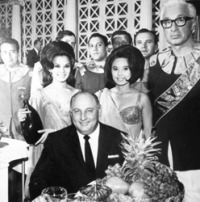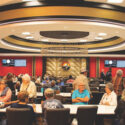
I may be biased—after all, I wrote his biography—but for my money Jay Sarno is the pivotal figure who explains why casinos look how they do today.
There have been plenty of casino builders over the years, and the word “visionary” is often thrown around loosely. But Sarno was a visionary by any measure. Here’s why.
Jay Sarno didn’t go into designing and building casinos to please a client or because market research told him it was a niche ready to be exploited. First and foremost, he did it because he was a gambler who thought that Las Vegas was missing the point. When Sarno first came to Vegas, as part of an Atlanta junket sponsored by the Flamingo in February 1963, he was appalled at the terrible plainness of everything that Las Vegas offered. The action at the craps table, sure, couldn’t be beat, but everything else was drab. The dealers dressed like clerks; the cocktail waitresses wore too much; the hotels looked even cheaper than they were.
Jay had a different vision of what Las Vegas should be. It was influenced by Miami’s Fontainebleau (where he met and wooed his future wife over the course of a week in 1957), but more profoundly by Jay’s understanding of what men (and, in those pre-liberation times, the focus was unapologetically on men) like him wanted in a casino.
Above all, that meant a place where the guest was the center of attention and could escape from reality, if only for a few days. When designing his first casino, Caesars Palace, Sarno used tricks he’d learned building motels in Atlanta, Dallas and Palo Alto. Using screen block as a façade was relatively cheap, and when backlit with lights at night, looked impressive. Statues and fountains classed the place up, putting customers in a frame of mind conducive to gambling large sums.
But most important was Sarno’s dictate that everything at Caesars Palace, from the matchbooks to the stationery to the employee uniforms, reference the Caesars Palace theme. Sarno and his designer, Jo Harris, did this with whimsy and tongue firmly in cheek; they didn’t intend to insult their patrons’ intelligence by trying to convince them that they were in Rome. Instead, the point was to build a casino that a Roman emperor would have felt comfortable in, and then substitute the individual customer for that Roman emperor.
From today’s perspective, the original Caesars Palace seems quaint. It’s small (less than 700 rooms) and, to our sensibilities, unsophisticated. But Sarno’s big idea—to wrap the experience around the customer—has profoundly affected the design of every good casino built since then. To use today’s vernacular, we’d call the Sarno approach customer-centric. At the end of the day, that’s who he was building for: the average customer, who he imagined as a man not so different from himself, with not so different desires. Give someone attention, give them comfort, give them beauty—just spoil them a little—and, Sarno understood, they’d come back.
Sarno’s other casino doesn’t have quite the cachet of the original. He built Circus Circus only two years after Caesars Palace (internal squabbles put an end to the original Caesars partnership) and initially catered to high rollers. Handicapped by its lack of a hotel (and, federal agents alleged, massive skimming), Circus Circus underperformed. But Sarno was ahead of the curve. In addition to the high rollers, he reached out to slot players, believing that this was a burgeoning part of the business that everyone else was missing out on. When it opened, Circus Circus had more slots than any other Las Vegas casino. Again, he was ahead of his time; by the early 1980s, even Strip casinos had transformed into slot barns with a core of table games.
The most important reason to know more about Sarno, though, isn’t what he did. It’s how he did it. Whether it was marathon gambling sessions with best friend Evel Knievel, being accused of offering the biggest bribe in IRS history (he hired Oscar Goodman to defend him), or enjoying the many pleasures that Las Vegas had to offer a man with few inhibitions, Sarno wasn’t capable of doing anything small. He was a colorful character; and it is colorful characters who built the casino industry we know today.
While it’s not advisable to duplicate Sarno’s excesses (or his choice of business partners), we can learn a great deal from his career. He still shows us that it’s not enough to know how to run a casino; you need to have a feel for why people are there in the first place to build one that will work. When owners and managers and designers get away from that basic truth, they begin to go wrong. Sarno put the customer smack dab in the middle of his space, and designed the casino around him. And for that, he should be a name that everyone one in the casino business remembers.

















